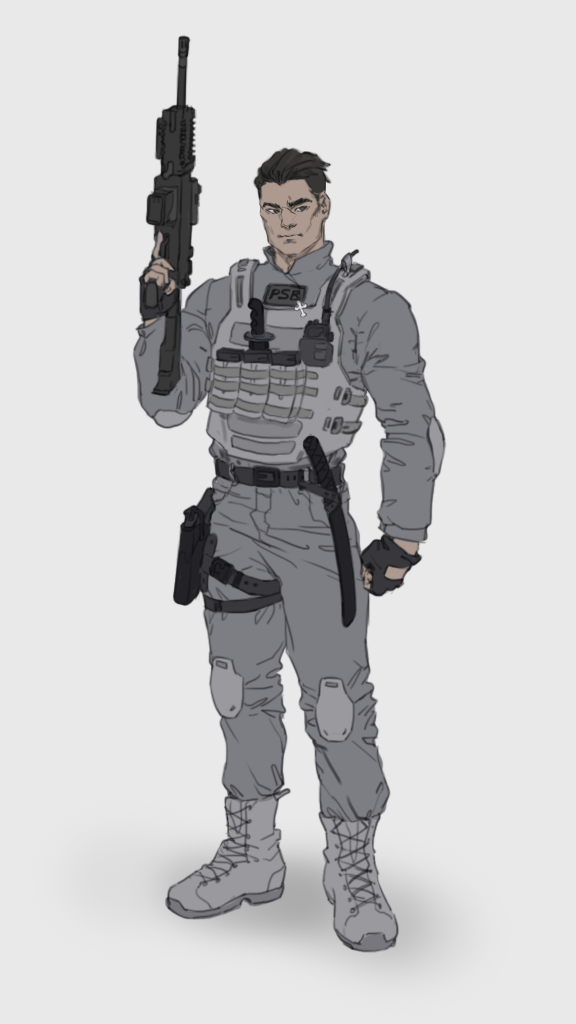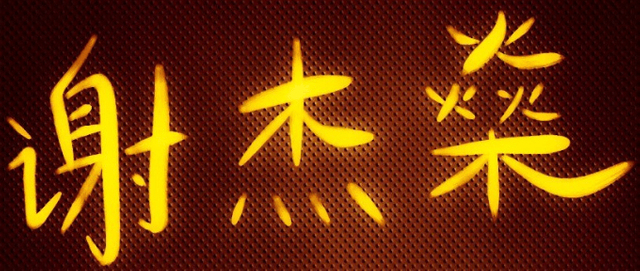The Blades of Babylon

Swords are cool.
That alone would be enough reason to include swords in fiction. And you can't have a street samurai without a sword.
But my preferred aesthetic, that of the military technothriller, demands greater justification than just 'cool'. And for good reason: soldiers must justify every piece of gear they carry on a mission. Unnecessary gear just slows you down and takes up space. On the modern battlefield, where death is routinely dealt beyond visual range, there's no place for a sword.
Or is there?
James Williams, master of ancient samurai military arts, noted that in the Middle East, soldiers found themselves fighting threats high on drugs. The 5.56x45mm NATO round, already considered anemic in many circles, couldn't stop them, even with multiple hits. The attackers may take fatal wounds, but until they bleed out or suffer a central nervous system hit, they will just keep coming.
As such, Special Operations troops requested Williams to produce a special kind of knife. A long, heavy knife, capable of cutting through a limb with a single blow. That way, it doesn't matter how drugged-up a threat is. If he doesn't have a hand any more, he can't hold a weapon and he can't harm you.
This story from SOFREP describes another knife use case. In 2011, a gang of pirates hijacked a boat and killed all four passengers. A team of US Navy SEALs boarded the yacht to take down the pirates. During the raid, one of the pirates decided to play dead. An alert SEAL spotted the pirate opening his eye. The SEAL couldn't shoot the pirate for fear that the bullet would punch through the floor and hit his comrades on the lower decks, so he finished him off with his knife.
The Special Operations Combatives Program illustrated a third example of knife use in modern combat: an aggressor jumping on a soldier as he makes entry in a room and wrestling for his gun. The threat is too close to engage with a firearm. A solution is to draw a knife, defeat the grab attempt, and finish the threat. This may require stabbing and cutting him off, but it could also entail using the knife as a lever to facilitate throws and other maneuvers.
From these three scenarios, we see when a knife is used in modern war: to neutralize pain-resistant attackers, to engage threats in close quarters where overpenetration and collateral damage is a risk, and to fend off gun grabs and attempted takedowns.
With these three use cases in mind, I set about searching for suitable blades to arm a street samurai.
The Art of the Knife
The world of BABYLON BLUES is populated with monsters, sorcerers, cyborgs, and powerful demons. Capable of rewriting the laws of reality, the threat they pose to operators in that universe goes above and beyond the threats a soldier would face in ours.
In Babylon, there are Elect with the power to regenerate swiftly from wounds, even seemingly-mortal injuries. Husks that can transform into hulking beasts that can shrug off rifle rounds at point blank. Cultists that can teleport right up in your face.
It's every threat I've described above, but turned up to eleven.
Yuri Yamamoto, operator par excellence, would be intimately familiar with such threats, and would arm himself to meet them.
In line with the street samurai motif, I looked at James Williams' blade catalogue. With his in-depth experience and research into the samurai arts, I was confident that he could provide a solution.
And he delivered.
Yamamoto's primary combat knife is the OZK 002 Osoraku Zukuri Kaiken. Slim and low-profile, it can be carried and concealed almost anywhere. With its neutral textured handle, he can quickly manipulate the knife without losing his grip. The spine is exceptionally thick, making it extremely durable--and perfectly suitable as a lever, even when jammed inside a threat's body. In darkness and deep shadow, the matte black blade will disappear. The blade profile, modeled on the osoraku zukuri pattern, features an armor-piercing point, the better to reach deeply into a target's vitals.
When operational, Yamamoto prefers to mount his knife in a kangeroo pouch on his plate carrier behind his magazines. This allows him rapid access, especially in a wild melee. The dark handle blends into the fabric of his plate carrier, making it harder for the threat to spot until it's too late. In civilian clothes, he wears the blade horizontally edge-up on the left side of his belt, the way his samurai ancestors would have. In a high-risk situation, he could casually fold his hands over his belt, placing his hand on his handle. If he needs it, he could draw and thrust in the blink of an eye.
When he needs a longer blade, he turns to an o-tanto, a HZO 002 Hira Zukuri O-Tanto with the blade length of the Hisshou. An o-tanto is technically a long knife, but everyone recognizes it for what it is: a short sword.
The o-tanto is his signature weapon, the blade he carries into high-profile operations. With a single swing, he can sever a limb or a take off a head, decisively ending a confrontation. Against armored threats, he can grab the blade to thrust into unarmored points, almost like half-swording from European swordsmanship.
Other writers might go for a katana or a wakizashi. Their longer blades would certainly afford greater reach. However, Yamamoto expects to use his blades in very close quarters, so close that the extra length and mass would get in his way. He also appreciates the value of a long blade he can conceal under a jacket. The maximum blade length he will accept is twelve inches, and depending on the situation, he might pick a shorter blade. Any range handicap from a shorter blade can be easily overcome with the right footwork and body mechanics.
It is an unorthodox choice--but then, Yamamoto is an unorthodox man.
The Way of the Sword
With Yuri Yamamoto's portrayal as a street samurai, I sought to find a suitable Japanese martial art for him. A martial art that teaches the use of the blade, combining timeless wisdom and modern realities.
Nami-Ryu was perfect for my needs. Headed by James Williams, it took samurai military arts and applied them to modern warfare. On YouTube, Williams has published videos showing the application of Nami-Ryu principles to modern combat. Better yet, Nami-Ryu is itself descended from Yanagi-Ryu Aiki Bugei from the Yoshida clan, a classical samurai combat art.
To complement Nami-Ryu, I chose Systema. On first glance, they seem nothing alike. Nami-Ryu focuses on kata and swordsmanship; Systema uses freeflow sensitivity drills. However, Williams wrote multiple essays describing the many similarities in both arts, including their emphasis on relaxation, softness, and blending. On closer inspection, I saw what he saw, and agreed with his conclusions. Plus, incorporating Systema would further cement Yamamoto as a man of East and West, old Japan and ancient Russia.
Hollywood and pop culture portrays sword combat is crude, unsophisticated ways, or emphasise flash and style over substance. You have characters spinning and twirling and jumping and otherwise performing acrobatics, characters who batter their way through the enemies' ranks, characters who handle their weapons as though they were bats or clubs instead of cutting tools. With Babylon Blues, I wanted to give the reader insight into how high-level samurai combat could have taken place.
Hard blocks are virtually nonexistent in Yamamoto's arsenal. He faces threats so powerful, it is impossible for a mere man with mortal strength to confidently block a blow without being overwhelmed. Likewise, relying on power, speed, or reaction time is useless; there will always be someone stronger and faster than you, especially in the world of Babylon.
Instead, the foundation of Yamamoto's art is deception and blending.
The art of war is deception. In a world populated by berserkers, giants, cyborgs and other inhuman monsters, deception is one of the few tools Yamamoto has that can't be nullified through magic or technology.
There are many techniques to deceive the enemy. Appearing to go in one direction, but in reality going in another. Masking small motions with large ones. Surreptitiously drawing a weapon before a high-risk encounter. Body movements that, to the attacker, appears to be taking you away from him, while in reality placing you in an advantageous location. All these, and more, are the cornerstones of Yamamoto's art.
When a strike comes in, he employs subtle cams and deflections to redirect the force vector, and shapes himself to blend with the force. Instead of traditional steps or shuffles, he pivots away from the line of attack, getting off the X while remaining close enough to deliver the decisive blow. Through body twists, turns, and other small motions, he remains unavailable, yet unavoidable.
The Japanese hold that the way of the sword is the way of strategy. Knowledge of the sword translates into knowledge of all weapons and other methods of war. In an integrated system of combat, body mechanics are universal across all modalities. Sword cutting mechanics are the same mechanics for grappling and throwing; empty-hand movements translate to pistol draws and manipulations; polearm work can be adapted to long guns; sensitivity, deception and footwork apply to all methods of combat.
Executing these techniques under pressure requires a mindset vastly different from other martial arts. It demands relaxation, softness and looseness, the better to feel the incoming force vector and the target. Precision and subtlety are prized over gross motor skills and raw aggression. Instead of meeting force with force, you redirect the incoming energy, lead the enemy into a sudden void, and return his energy as a strike he won't see coming.
Most of all, this way of combat requires faith.
It requires giving up your ego, letting go of all attachments to outcomes and prejudices, to see the world exactly as it is. To give up contesting for space and move as the situation demands. To recognize that inherent in every problem is its solution. To sense and receive forces great and subtle beyond yourself, and shape them to your needs. To recognize that the universe returns what you send out, and that you can be part of the great chain of energy return. To relax and become totally free.
And for a man defined by faith, there is no better art.

Enjoy stories of street samurai fighting monsters, cultists and false gods? Back BABYLON BLUES on Kickstarter here!
One thing I love about the blending of fantasy and science is things like this. The need for a sword when a bullet won't do.
I also think about the Tueller Drill. The 6.1m distance for a human to beat a gun shooter seems like a lot of distance, when you include things like speed in there, knives can be a lot faster. Now, slightly difference, but it does point out the sweet spot where a blade is better.
Plus, I love people who use short sorts of any form. They are my favorite weapon.
Thank you!
Thanks for reading!
To listen to the audio version of this article click on the play image.

Brought to you by @tts. If you find it useful please consider upvoting this reply.